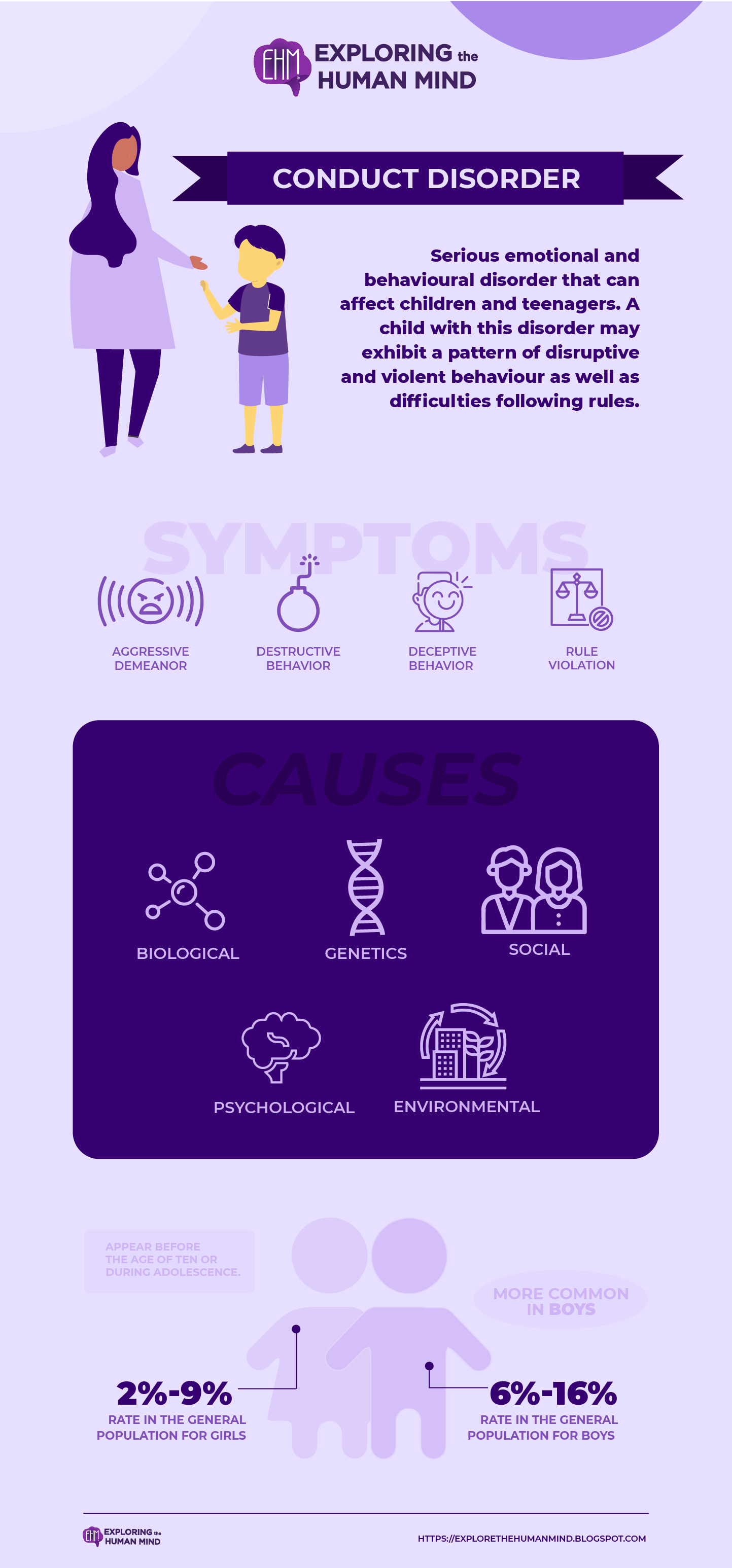Conduct Disorder
It is not uncommon for children and teenagers to experience behavioural issues at some point during their development. However, the behaviour is considered a conduct disorder when it is persistent, violates the rights of others, deviates from accepted norms of behaviour, and disrupts the child's or family's daily life.
Symptoms
The symptoms of conduct disorder differ depending on the child's age and whether the disorder is mild, moderate, or severe. In general, conduct disorder symptoms fall into four categories:
- Aggressive demeanor: Fighting, bullying, being cruel to others or animals, using weapons, and forcing another into sexual activity are examples of behaviors that threaten or cause physical harm.
- Destructive behavior includes intentional property destruction such as arson (deliberate fire-setting) and vandalism (damaging another person's property).
- Deceptive behavior can include lying repeatedly, shoplifting, or breaking into homes or cars to steal.
- Rules violation: This involves breaking accepted social rules or engaging in behaviour that is inappropriate for the person's age. These behaviours may include fleeing, skipping school, pulling pranks, or engaging in sexual activity at a young age.

vectors by Freepick; graphic design by Vadot
Causes
Many factors, according to experts, contribute to conduct disorder. Some children with conduct disorders appear to have a problem in their frontal lobe. This impairs a child's ability to plan, avoid harm, and learn from negative experiences.
The exact cause of conduct disorder is unknown, but a combination of biological, genetic, environmental, psychological, and social factors are thought to be involved. Possible causes:
- Biological: According to some studies, defects or injuries to specific areas of the brain can result in behavioural disorders. Conduct disorder has been linked to specific brain regions involved in behaviour, impulse control, and emotion regulation. If nerve cell circuits along these brain regions do not function properly, conduct disorder symptoms may occur. Furthermore, many children and adolescents with conduct disorder also have other mental illnesses, such as attention-deficit/hyperactivity disorder (ADHD), learning disorders, depression, substance abuse, or an anxiety disorder, which can exacerbate the symptoms of conduct disorder.
- Genetics: Many children and adolescents with conduct disorder have close family members who suffer from mental illnesses such as mood disorders, anxiety disorders, substance use disorders, and personality disorders. This suggests that conduct disorder vulnerability is at least partially inherited.
- Environmental: A dysfunctional family life, childhood abuse, traumatic experiences, a family history of substance abuse, and inconsistent parental discipline may all play a role in the development of conduct disorder.
- Psychological: Some experts believe that conduct disorders can be caused by issues with moral awareness (particularly a lack of guilt and remorse) as well as cognitive processing deficits.
- Social: Low socioeconomic status and social rejection appear to be risk factors for the development of conduct disorder.
Most researchers are unsure why some children develop conduct disorder. A traumatic experience, social issues, and biological factors may all be involved. Positive parenting strategies can help parents reduce their child's risk of developing this disorder. This can aid in the development of a stronger parent-child relationship. It can also provide the child with a safe and stable home life.
Boys are more likely than girls to suffer from conduct disorder, with the ratio ranging from 4:1 to 12:1. The lifetime prevalence rate in the general population can range from 2 to 10% and is consistent across race and ethnic groups.
Conduct disorder is more common in boys than in girls, with studies indicating that the rate in the general population for boys ranges from 6% to 16%, while the rate in the general population for girls ranges from 2% to 9%. Conduct disorder can appear before the age of ten or during adolescence.
Although conduct disorder has a global prevalence of about 5% and is one of the most common reasons for referral to mental health services, it is one of the least widely recognised and studied psychiatric disorders.
Reference:
Conduct Disorder. (2023, May 8). Hopkinsmedicine.org. https://www.hopkinsmedicine.org/health/conditions-and-diseases/conduct-disorder
Mental Health and Conduct Disorder. (2003, February 9). WebMD. https://www.webmd.com/mental-health/mental-health-conduct-disorder Mohan, L., Musa Yilanli, & Ray, S. (2023, March 13). Conduct Disorder. Nih.gov; StatPearls Publishing. https://www.ncbi.nlm.nih.gov/books/NBK470238/#:~:text=Conduct%20disorder%20is%20more%20common,different%20race%20and%20ethnic%20groups.






Comments
Post a Comment